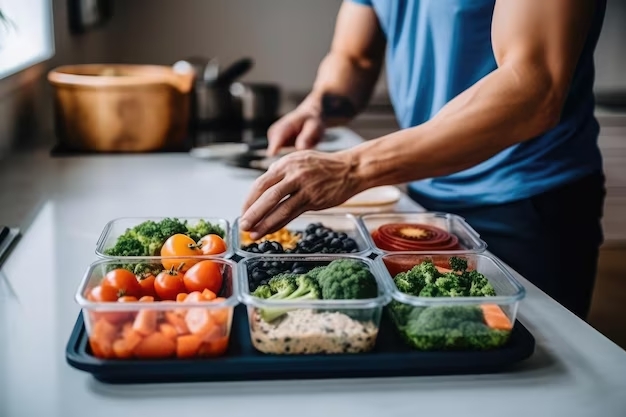
Healthy Meal Prep for Busy Lifestyles: A Guide to Eating Well Amid the Chaos
In today’s fast-paced world, balancing work, family, and personal commitments often leaves little time for cooking nutritious meals. For busy individuals, the temptation to grab fast food or skip meals altogether can derail health goals. However, with strategic meal prepping, it’s possible to enjoy wholesome, balanced meals without sacrificing time or energy. This guide offers practical tips, recipes, and strategies to make healthy eating achievable, even for the busiest schedules.
Why Meal Prep Matters
Meal prepping—the practice of preparing meals or ingredients in advance—saves time, reduces stress, and promotes healthier choices. Benefits include:
-
Time Efficiency: Dedicate 2–3 hours weekly to avoid daily cooking.
-
Cost Savings: Reduce reliance on takeout and minimize food waste.
-
Portion Control: Pre-portioned meals prevent overeating.
-
Nutritional Balance: Ensure meals include proteins, veggies, and whole grains.
Studies show that people who meal prep consume more fruits, vegetables, and fiber while eating fewer processed foods.
Step 1: Plan Smart
:max_bytes(150000):strip_icc()/ew-summer-lunch-mp-rainbow-960-98590667f9a54d9b86ec2242e4ab5a6c.jpg)
Success starts with a clear plan tailored to your schedule and dietary needs.
1. Set Realistic Goals
-
Start small: Prep 2–3 days’ worth of meals if you’re new to the process.
-
Focus on one meal type (e.g., lunches or snacks) before expanding.
2. Build Balanced Menus
Use the “Plate Method” as a template:
-
50% Vegetables: Roast broccoli, spinach, or bell peppers.
-
25% Protein: Grilled chicken, tofu, lentils, or fish.
-
25% Whole Grains: Quinoa, brown rice, or whole-wheat pasta.
-
Healthy Fats: Add avocado, nuts, or olive oil.
3. Create a Shopping List
Organize ingredients by category (produce, proteins, pantry staples) to streamline grocery trips.
Step 2: Master Time-Saving Strategies
Maximize efficiency with these hacks:
1. Batch Cooking
-
Cook large quantities of staples like grains, proteins, and roasted veggies.
-
Example: Grill 5 chicken breasts, roast a tray of sweet potatoes, and cook 3 cups of quinoa.
2. Repurpose Ingredients
-
Turn last night’s grilled salmon into a salad or wrap.
-
Use roasted veggies in grain bowls, omelets, or soups.
3. Use Kitchen Tools
-
Slow Cooker/Instant Pot: Prepare soups, stews, or shredded meats hands-free.
-
Sheet Pans: Roast proteins and veggies simultaneously.
-
Mason Jars: Layer salads or overnight oats for grab-and-go meals.
Step 3: Simple, Nutrient-Dense Recipes
These versatile recipes require minimal prep and keep well for 3–4 days:
1. Breakfast: Overnight Oats
-
Combine rolled oats, almond milk, chia seeds, and Greek yogurt in a jar.
-
Top with berries and nuts before serving.
2. Lunch: Mason Jar Salad
-
Layer dressing, hardy veggies (carrots, cucumbers), proteins (chickpeas, grilled chicken), and greens.
-
Shake and eat fresh.
3. Dinner: Sheet-Pan Chicken & Veggies
-
Toss chicken thighs, broccoli, and bell peppers with olive oil, garlic, and paprika.
-
Roast at 400°F (200°C) for 25 minutes.
4. Snacks: Energy Bites
-
Mix oats, peanut butter, honey, and dark chocolate chips. Roll into balls and refrigerate.
Step 4: Storage Solutions

Proper storage preserves freshness and prevents spoilage.
-
Containers: Use BPA-free, leak-proof containers in portioned sizes.
-
Labeling: Note dates and contents (e.g., “Chili – 5/20”).
-
Freezing: Soups, casseroles, and cooked grains freeze well for up to 3 months.
Food Safety Tips:
-
Refrigerate meals within 2 hours of cooking.
-
Reheat to 165°F (74°C) to kill bacteria.
Step 5: Stay Motivated
Consistency is key. Overcome common hurdles with these tips:
1. Combat Boredom
-
Rotate 2–3 weekly menus to keep meals exciting.
-
Experiment with global flavors: Try Mexican-inspired bowls or Asian stir-fries.
2. Involve the Family
-
Assign tasks: Kids can wash veggies or assemble snacks.
-
Host a “prep party” with friends to swap recipes.
3. Track Progress
-
Note how meal prepping saves time or improves energy levels.
-
Celebrate small wins, like resisting takeout for a week.
Sample 3-Day Meal Plan

Day 1
-
Breakfast: Greek yogurt with granola and blueberries.
-
Lunch: Quinoa salad with grilled chicken, spinach, and balsamic dressing.
-
Dinner: Sheet-pan salmon, asparagus, and farro.
-
Snack: Apple slices with almond butter.
Day 2
-
Breakfast: Spinach and feta omelet with whole-grain toast.
-
Lunch: Lentil soup with a side of whole-grain crackers.
-
Dinner: Turkey meatballs with zucchini noodles and marinara.
-
Snack: Veggie sticks with hummus.
Day 3
-
Breakfast: Smoothie (spinach, banana, protein powder, almond milk).
-
Lunch: Whole-wheat wrap with turkey, avocado, and veggies.
-
Dinner: Stir-fried tofu with brown rice and broccoli.
-
Snack: Dark chocolate-covered almonds.
Conclusion: Embrace the Meal Prep Mindset
Healthy meal prepping isn’t about perfection—it’s about progress. By dedicating a few hours each week, busy individuals can reclaim control over their diets, reduce decision fatigue, and fuel their bodies with nutrient-rich foods. Start with one recipe, invest in quality containers, and gradually build a routine that fits your lifestyle. Remember, the goal isn’t to cook Instagram-worthy meals every day; it’s to create sustainable habits that support long-term health and well-being. With a little planning and creativity, even the busiest schedules can accommodate wholesome, delicious eating.





